The GeForce GTX 770 Review: Calling In A Hit On Radeon HD 7970?
Wait, the new GeForce GTX 770 is powered by Nvidia's old GK104? That's right. And guess what? The card is faster, quieter, more feature-complete, and less expensive than the GeForce GTX 680 that came before it. Can it usurp the compelling Radeon HD 7970?
Power Consumption
All measurements were taken directly at the card, since measuring system performance is not exact enough. After all, different graphics loads affect processor utilization differently, causing system power to fluctuate.
The direct comparison between the GeForce GTX 770 and 680 is especially interesting, since the newer card offers higher gaming performance thanks to its increased clock rates. Is this performance delta also reflected in power consumption? At least when they're idle, both boards draw roughly the same amount of power.
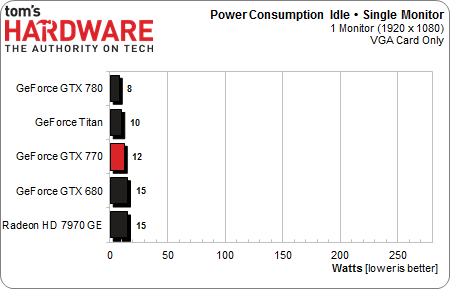
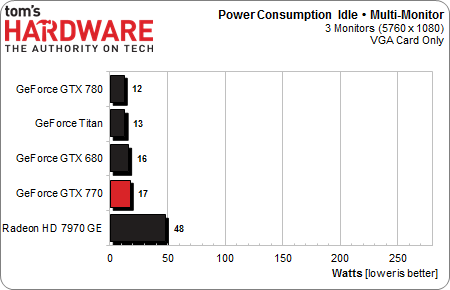
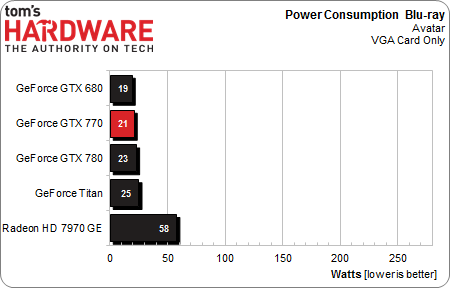
Higher performance isn't free, and we get a first glimpse of that in our gaming workload, where the GeForce GTX 770 slots in between the 680 and 780 once more. That’s pretty much in line with its performance. Still, the GeForce GTX 680 is more efficient overall. We can also infer that the 770 is operating beyond the GK104 GPU’s sweet spot, since gaming performance falls closer to that of the GTX 680.
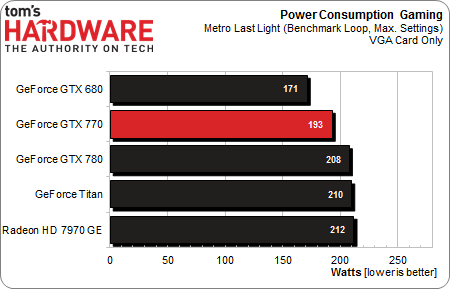
The GeForce GTX 770 proves much more power-hungry than the 680 in pure compute applications. Interestingly, the older card seems to be running into its hard-wired power target. On the other hand, the 770 only sustains its higher performance level until it hits its own respective thermal target.
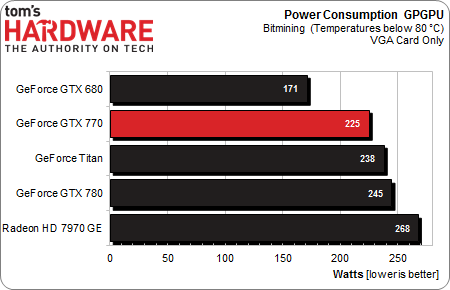
As long as the cards don’t exceed their predefined thermal or power limits, they can hit power peaks beyond what their nominal TDP would allow. In practice, you only see those situations rarely, and very briefly at that. Still, don’t forget to take them into account and pick your power supply accordingly.
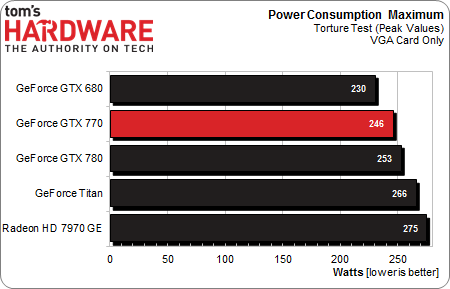
Effects of the Thermal Limit
Now let’s see what happens when these cards run into their thermal ceilings after crunching away under load for a while. Like the GK110-based GeForces, the 770 has to throttle back its frequency, noticeably impacting power consumption and gaming performance. We can take this as another indication of how well GPU Boost 2.0 exploits more of a GPU's headroom until that thermal threshold is reached, provided the chip is cooled adequately.
Stay On the Cutting Edge: Get the Tom's Hardware Newsletter
Get Tom's Hardware's best news and in-depth reviews, straight to your inbox.
And therein lies the rub. Because Nvidia obviously aimed to keep its reference card as quiet as possible, opting for a very conservative fan speed curve, the 770 almost always reaches its thermal limit during longer gaming sessions. Conversely, if Nvidia were to modify the reference design’s fan curve, allowing the card to remain cool enough to prevent throttling, it would have ended up with a much louder product.
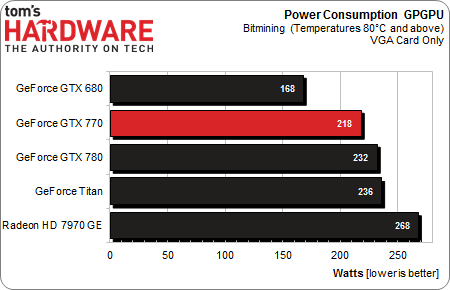
A look at any online store is enough to know that add-in board partners are moving beyond the reference design with this launch. On the next page, we will compare the reference card to three partner boards with third-party coolers to see how they fare when it comes to boost speeds. After all, this is the one factor that will determine a card’s performance under a real-world load.
Current page: Power Consumption
Prev Page OpenCL: Double-Precision Next Page Heat, Clock Rates, And Noise-
EzioAs Thanks for the article.Reply
Kind of an expected performance increase. Seeing overclocked GTX 680 review was conclusive enough unless you've never seen one. Never expected this card to be getting the Smart Buy award though to be completely honest.
Hey, how about another title for the review?
- GTX 680 Gets a New Cooler, BIOS Update and Price Drop! -
No? I'll think of a better one... -
CarolKarine the fact that every single site is comparing nvidia's next-gen stuff with AMD's current gen stuff kinda sickens me. don't start throwing around "Nvidia's got this gen in the bag" till we see what AMD comes up with. they've had what, 1 1/2, 2 years? I'm hoping for GCN 2 and a die shrink on a new architecture.Reply -
Memnarchon EzioAsNever expected this card to be getting the Smart Buy award though to be completely honest.Better power consumption than 7970GE.Reply
Less noise than 7970GE.
Runs cooler than 7970GE.
Same FPS as 7970GE.
$50 less cost.
Yeah indeed, why to get the Smart Buy award I wonder... -
GMPoisoN Reply10884687 said:When you factor in the 4 games that come with the HD7970 GHz Edition, it is still cheaper than the GTX 770. I find it odd that nVidia had over a year to come up with something to beat AMD in single GPU performance at this price point but failed to deliver.
Yes, there is a bit of power savings. Yes, multi-GPU performance is better. But, that is nothing new. I also wouldn't expect future drivers to deliver much in the way of performance improvements since this card is essentially a GTX 680 v2.
Ultimately, I expected more from nVidia. Yes, this is a polished card out of the gate. But I'm not sure the release of this card will affect AMDs bottom line as things currently stand, performance wise.
Agreed. Sapphire 7970 Ghz ftw <3 -
SiliconWars None of Nvidia's partners are using the reference cooler so this is just a scam to get better turbo clock speeds and good scores on quiet and cool operation. You've been had Chris and now you've spread Nvidia's lies to your readership.Reply
